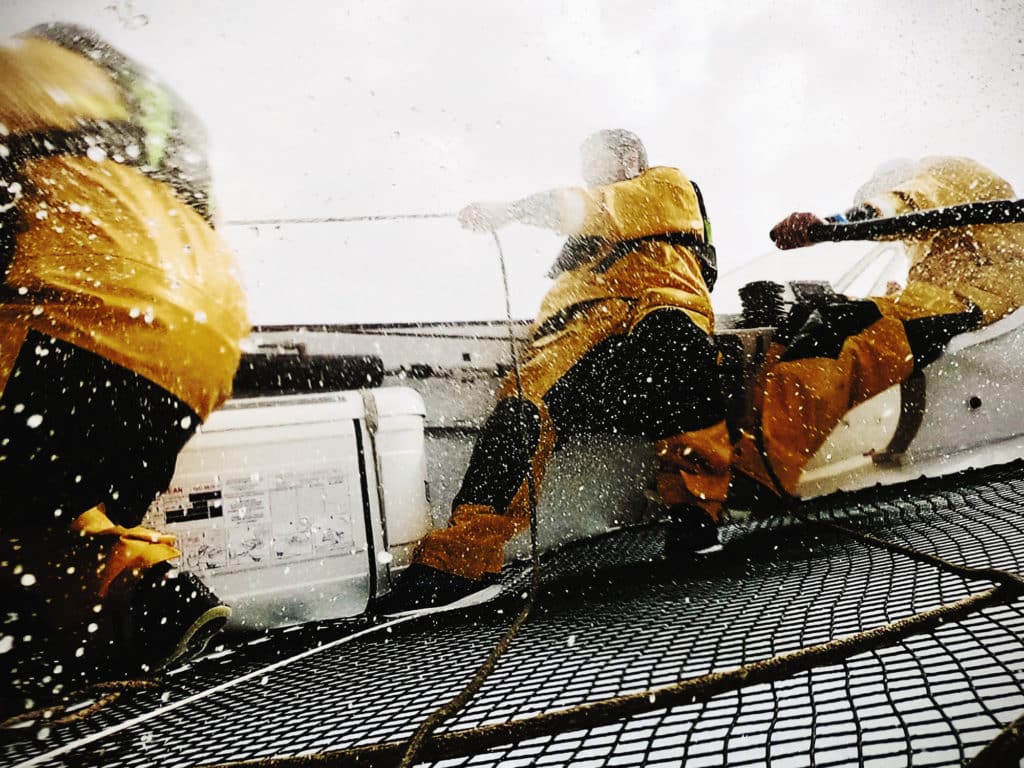
Moments after the start, the boatspeed jumps to 35 knots, and I am terrified. If I was driving, I’d be white-knuckled. The wind-whipped Caribbean Sea thrashes Argo’s hulls, but Jason Carroll is cool at the tiller of his 70-foot trimaran. He leans back in his driving chair and squints through the visor of his crimson helmet at the turning mark ahead.
A few days earlier, one of Argo’s new T-foil rudders snapped during the delivery from Antigua to St. Martin for the Caribbean Multihull Challenge regatta—a delivery of less than four hours despite the breakage. Carroll’s team spent the night swapping to Argo’s older rudders, but combined with the boat’s newer and longer J-shaped foils, the boat isn’t set up correctly. “Things could get a bit sporty out there,” Carroll had warned me before we shoved off. “As long as the conditions aren’t too crazy, we should be fine.”
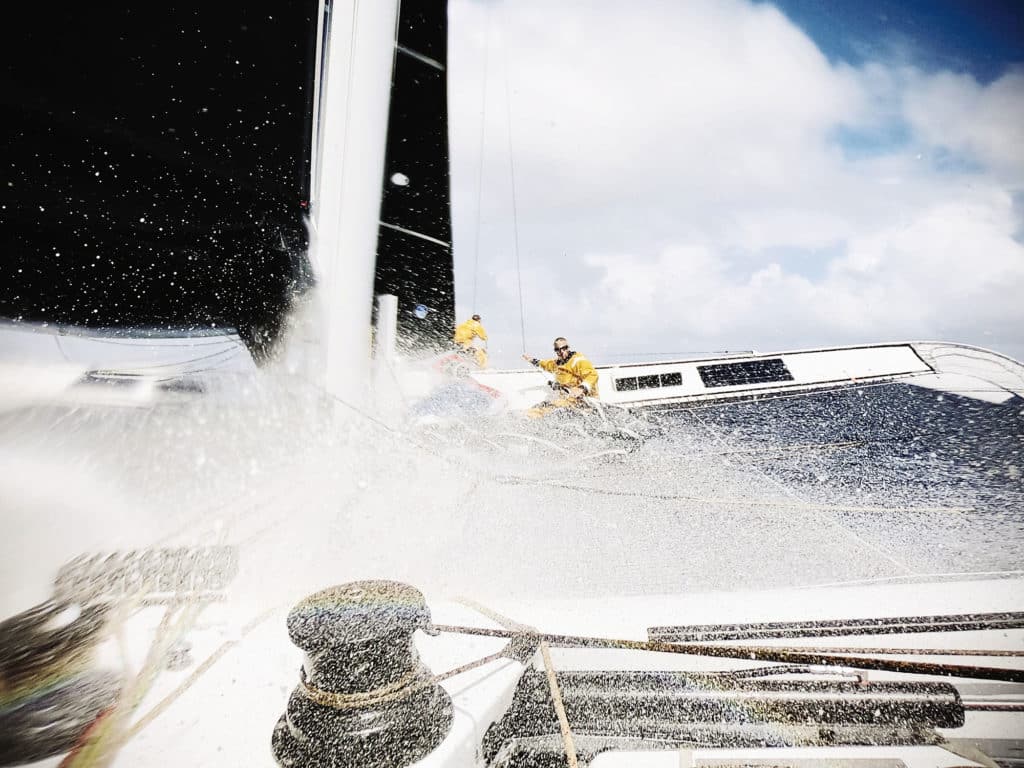
So much for that. With 30-knots blowing across the bows, we hurtle out of Simpson’s Bay, and I take a knee at the back of the cockpit and brace for dear life. I’ve seen the video of Argo’s capsize before the 2019 Caribbean 600, so I’m stoked with my decision to extend my insurance coverage to include extreme watersports. Still, I’m having one of those what-have-I- gotten-myself-into moments—one hand gripping a GoPro, the other clenching the lifeline.
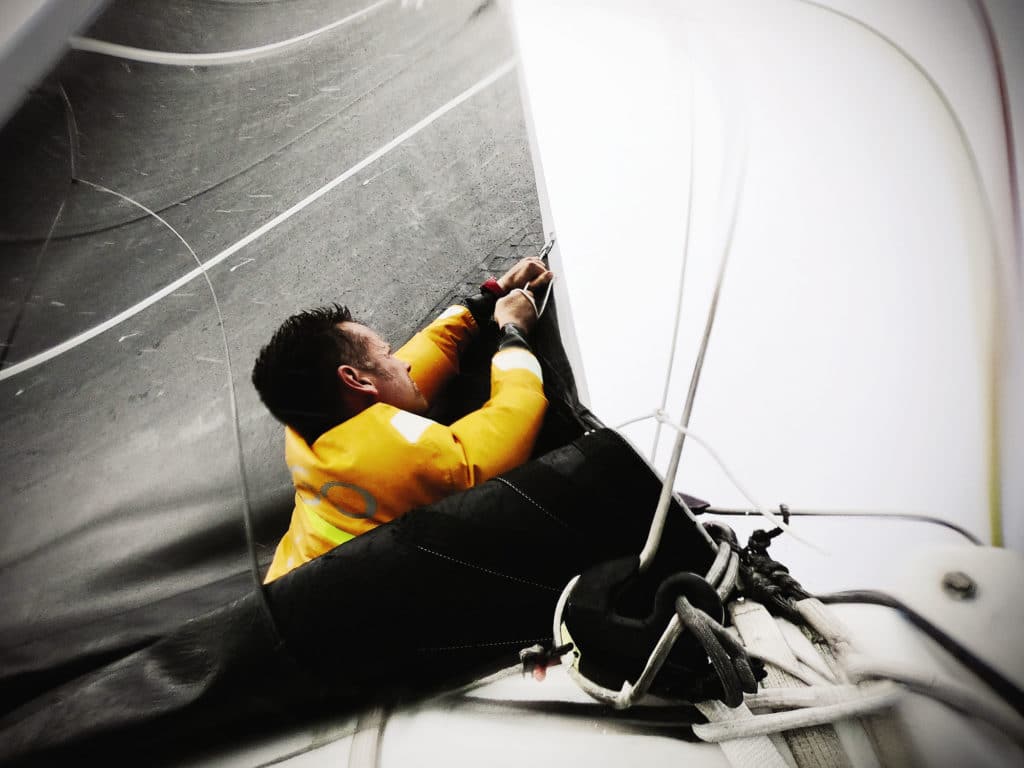
Carroll and company outmaneuver the other MOD70, Maserati, leaving them behind in trio of wakes. Ahead, Serge Durrant’s Irens 63, Shockwave, cruises along with a storm jib and three mainsail reefs. The Argonauts tucked only two reefs, and in a blink, the boat is careening past Shockwave. A gust fills the sails and the speedo jumps again—this time to 39 knots. The boat shudders as waves smack its underbelly; up forward, the bows begin to rise.
I’m having one of those what-have-I-gotten-myself-into moments—one hand gripping a GoPro, the other clenching the lifeline.
T-foil rudders would have prevented the bows from riding too high, but the big J-foils generate so much lift that water flowing over them begins to boil, causing cavitation. Argo’s bows slam into a trough, and the front beam takes a direct hit. In a situation such as this, one of two things can happen, and the outcome depends on Carroll’s ability to make the correct split-second decision. Option A is to ride it out and hope the trimmers ease the sheets quick enough to depower the sails. If they fail to do so, the entire crew will soon be dogpiling through the companionway as the boat pitchpoles. Option B is for Carroll to make a sharp turn to try to spill power quickly.
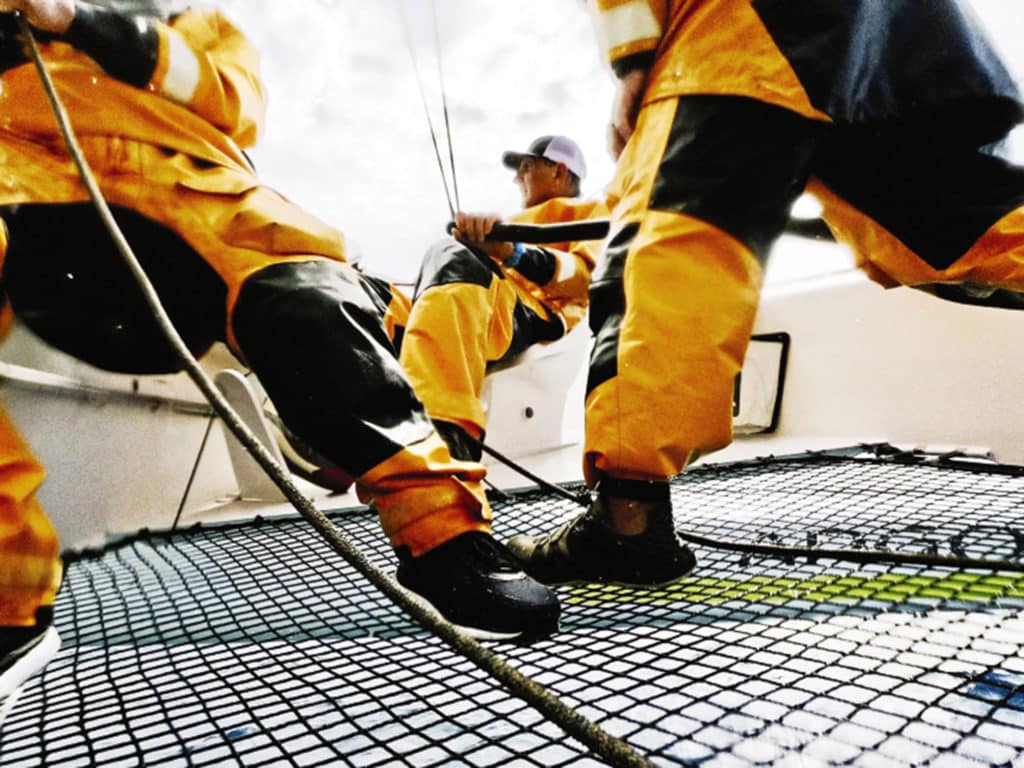
The 42-year-old helmsman chooses wisely, pulling down the bows with authority. The foils regrip, and after this little pucker moment, Carroll guides the trimaran through a wide, arcing turn upwind around the mark. The Argonauts are safe for now, but challenges await.
“The boat is actually easy to steer when everything is set up right,” Carroll says. His relaxed and intellectual demeanor is a calming presence, contrary to the sheer madness of the trimaran. As a co-founder of Hudson River Trading, Carroll put his Harvard computer science degree to use developing high-frequency trading algorithms, and when he’s not flying across the ocean, he’s soaring across the sky as an enthusiast pilot. Yet the MOD70 is like nothing else he has experienced. “We’re hitting speeds we never imagined,” he says. “But nothing happens out here without having complete trust in the guys next to you, so it all comes down to the team.”
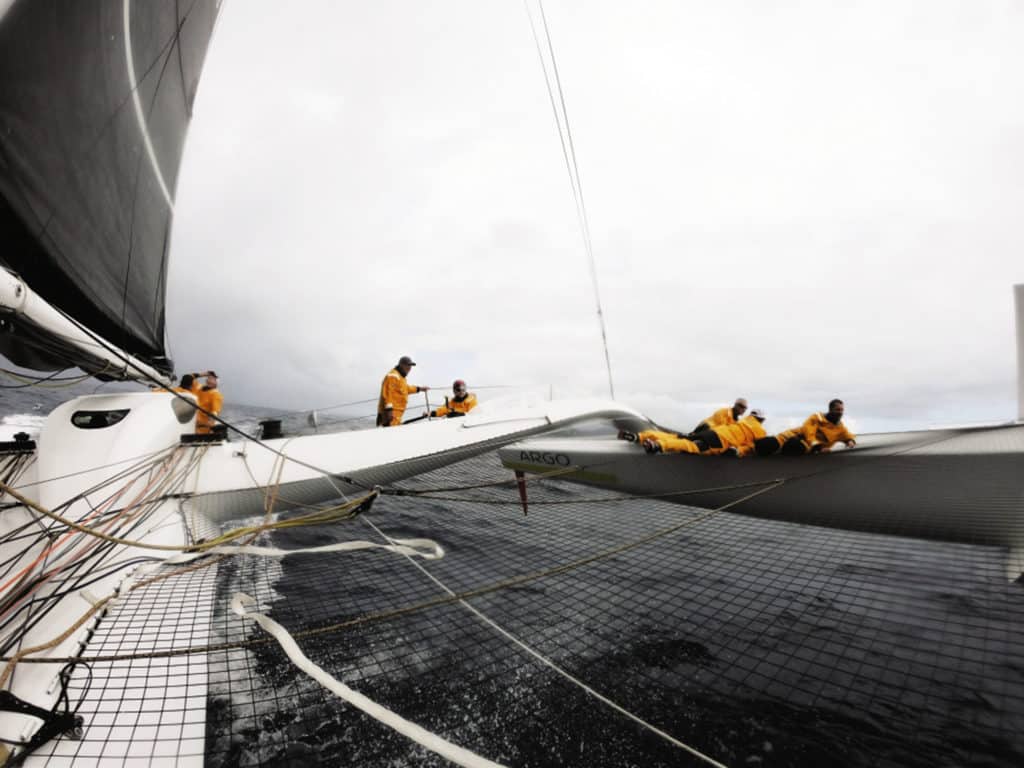
The Argo crew is a lean but talented squad. Such a boat demands experience. At its core is 48-year-old Chad Corning, who manages the operation. He’s been Carroll’s go-to guy since before they captured back-to-back Melges 32 World Championship titles in 2013 and 2014. When he first started sailing with Carroll, Argo was an all-amateur team of college buddies. “The scope of the program was small,” Corning says. “Eventually, we started sailing internationally and doing distance racing on Jason’s Gunboat 62, Elvis. At one point, we even had three Melges 32s. It just became too much for Jason to organize on his own, so I stepped in.”
The two have been thick as thieves for years, and the team eventually transitioned into the GC32 foiling catamaran scene, a circuit that pitted Carroll, an amateur helmsman, against a few of the finest pro drivers in high-performance sailing. In 2018, they traded in the Gunboat for the MOD70 and started racking up victories with a combination of longtime Argo teammates and specialized offshore multihull sailors, including Brian Thompson, the first Englishman to break the round-the-world record twice. Thompson has also sailed nonstop around the world four times, won the Volvo Ocean Race, and broken 27 world sailing records.
“He’s the guy who knows when to push and when to back off,” Corning says. His primary role on Argo is to act as point man for the boat’s complex maneuvers.
“This is very much a close-knit team,” Thompson says. “Jason is one of the best drivers out there. The guys know the boat really well, and they work hard maintaining everything to minimize breakdowns. Chad has done a remarkable job developing the boat and the team, and it’s good fun off the water as well.”
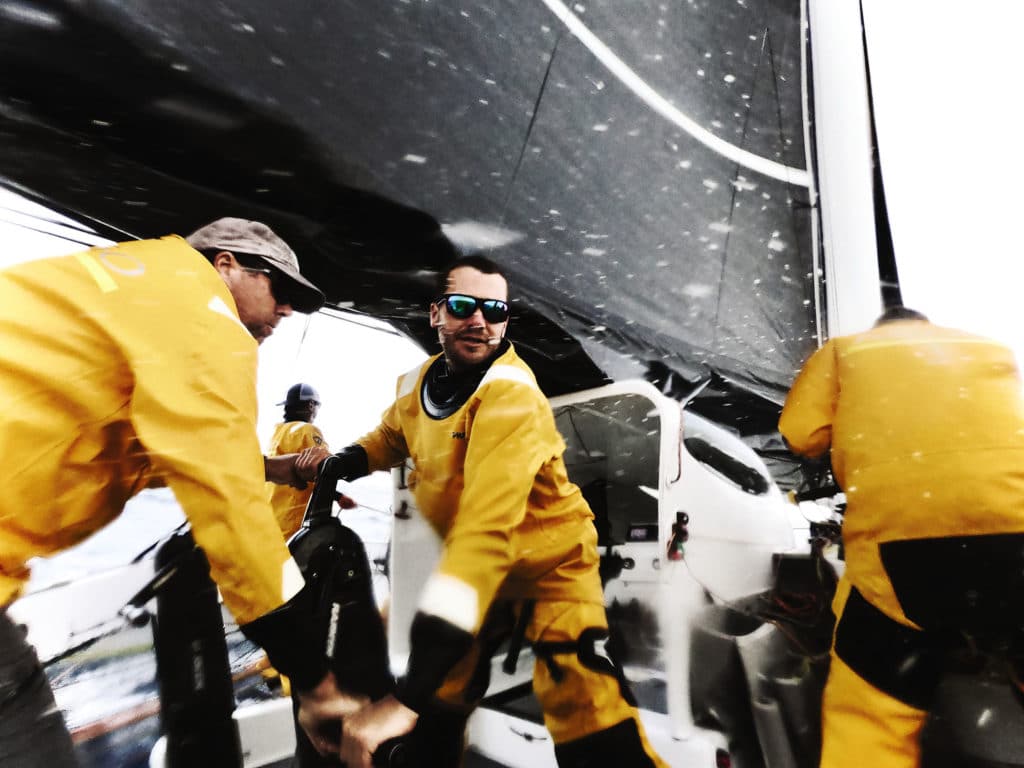
On the long beat toward the rounding point off Tintamarre Island on the northeast side of St. Martin, Thompson marshals the troops as the breeze spikes to 32 knots. With confused 6-foot swells, Argo smashes its way uphill at 21 knots. “I’d love a wider groove to get through these waves,” shouts mainsail trimmer, Anthony Kotoun. A five-time world champion in multiple classes, Kotoun is a longtime member of the Argo crew. He and Thompson chat for a moment and agree that a lower mode would be ideal.
“Let me check the course with Artie to make sure we have enough water to make that happen,” Kotoun shouts back to Thompson. While most pro race teams are known for their lack of shouting, with more than 50 knots of apparent wind funneling across the deck, communicating on this machine is like rolling down your window on the highway and trying to have a conversation with someone in the passing lane. “Communication is especially important because things don’t happen on demand,” Kotoun explains later. “The boat is so complicated with the foils, the canting mast, the rake and the centerboard that something as simple as a mode change can take minutes to achieve. You can’t just sheet out. It’s completely different than most things out there.”
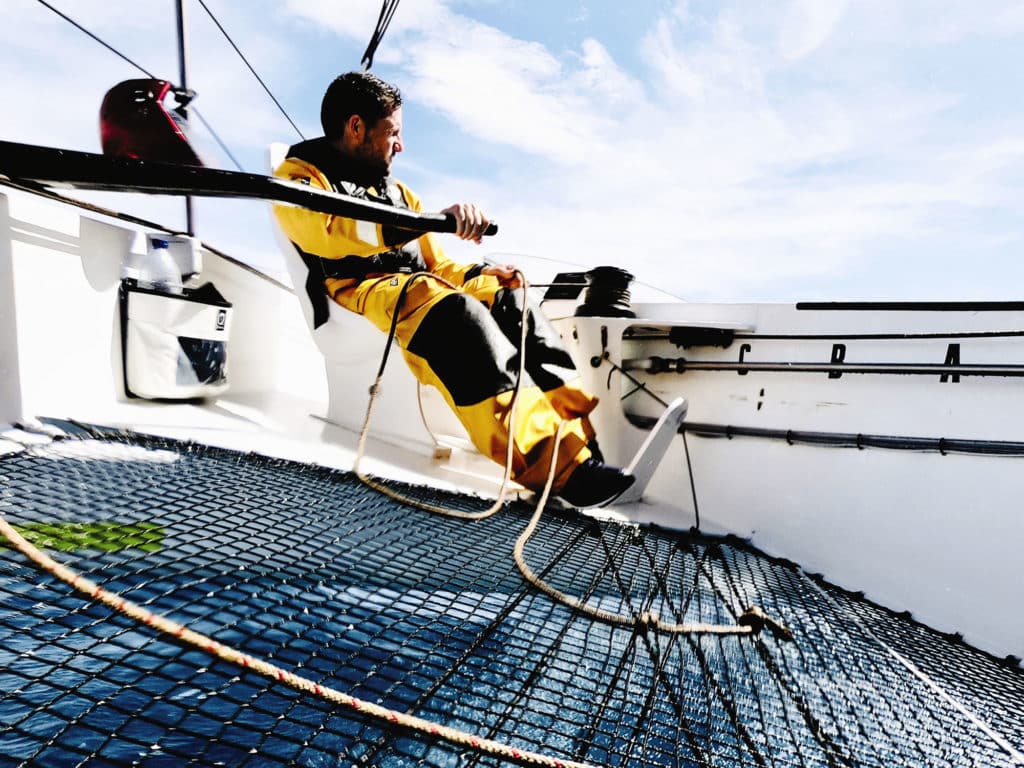
Kotoun staggers to the middle of the boat and pokes his head beneath the splash hood, where navigator Artie Means plots a course. Means has the most protected position on Argo, and he’s still soaked head to toe. His eyes are glued to his tablet.
“We can spare a few degrees, but not much,” Means says. “Luckily, we overstood a bit.”
Means and Kotoun take a moment to review the course, and eventually Kotoun makes his way back to the weather hull to relay the information to Thompson, who recalibrates the boat’s upwind mode by raising the centerboard up a bit, adding more foil rake, and moving the transverse jib-lead outboard. These changes allow the boat to sail lower without becoming overpowered. With a mainsheet load of 7 tons, the lines throb as they ease through their systems.
From beneath the spray hood, Means shoots me an ecstatic look as he nerds out over the instrument panels, which in true Argo fashion, have a dancing hula girl mounted above. “We’re going faster upwind than a TP52 would be going downwind today,” he says. “Hey Fouche, check this out!”
Headsail trimmer Thierry Fouchier pops his head beneath the spray hood. Fouchier is another international multihull legend. Originally from Marseille, France, Fouchier won the 34th America’s Cup aboard Larry Ellison’s big trimaran USA 17 before joining Artemis Racing in 2013 and Groupama Team France in 2017. Looking at the data, he gives Means a twisted smile. “C’est fou,”—That’s crazy—he says, returning to his jib-sheet winch.
Communication is especially important because things don’t happen on demand.
Thompson soon relieves Carroll at the helm as Argo pitches in the waves. “Be ready for a gennaker around Tintamarre,” Thompson shouts.
My God, I think to myself as water jets through the trampoline and the boat bucks me skyward off the netting, we still have to go downwind.
Even though the maneuver is 15 minutes away and the rounding point is over the horizon, the crew preps for the downwind leg. The biggest battle is hoisting the gennaker with the equivalent of tropical-storm-force winds blowing across the bow. Argo’s slender 31-year-old bowman, Westy Barlow, sprints forward and secures the tack while the grinders hoist the furled gennaker to the top of the mast. With Carroll back on the helm, Thompson reminds the trimmers to make sure the main is well-eased and the jib sheet stays on in order to keep the boat under control through the bear away. Once Argo reaches the right downwind angle, the crew explodes into action: deploying the gennaker, raising the centerboard, trimming the main- sheet, changing to the J2 headsail, reducing the mast cant, increasing the mast rotation and adjusting the traveler. When everything is set, Argo romps downwind at 30 knots.
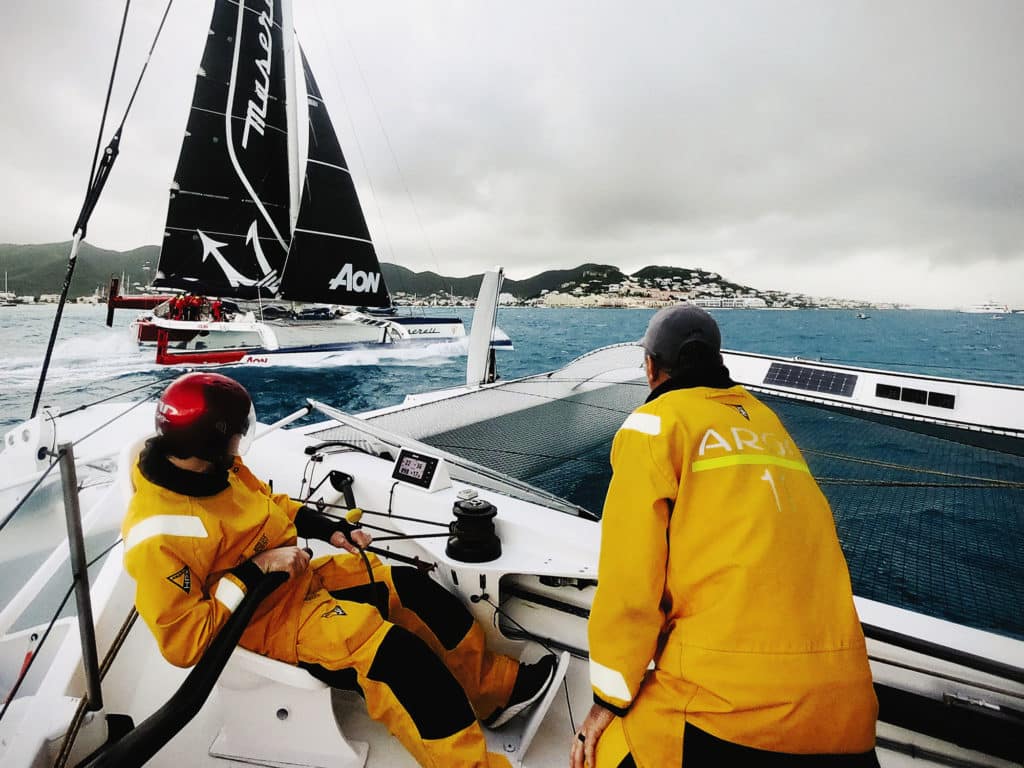
As we enter the Anguilla Channel, Shockwave is nowhere in sight and Maserati is still within striking distance. “Try not to go over 30 knots,” Thompson advises Carroll. “Anything more than that, and we might trip over ourselves.”
As Argo zips down the channel, trimmer and grinder Scott Norris taps me on the shoulder and asks, “Hey, can you go below and grab the big water jug and fill up the bottles?”
Norris is a big man with a big personality—one of the longest-tenured Argonauts on the crew.
“Where is it?” I ask.
“Thataway,” he says, pointing downward and aft.
Going below on a search mission is hardly what I want to be doing right now, but I scale the ladder into Argo’s center hull. Forward, the nav station is empty. Beyond that, a pair of berths hang in the dark. As Argo cleaves through the waves, sounds of unimaginable horror pound from wall to carbon wall like drums between warring villages. I crawl toward the stern, glancing out the porthole at our starboard hull, which hangs 15 feet above the waves. I snag the water jug and make it back topside, where Norris smiles down at me.
“Pretty gnarly down there, huh?” he asks as I reemerge. “Don’t worry, the first time we took this thing out, we were terrified. And today…terrified.”
“It’s going to be about a 100-degree reach after the turning mark,” Means shouts out to the crew. With Maserati shrinking on the horizon, Thompson decides to play this leg conservatively. “All right, it’s going to be the J3 and three reefs on the main,” he howls through the wind. This is the least amount of sail area Argo can carry, and when conditions are right, the reduced drag and lower center of gravity produce the highest speeds a MOD70 is capable of, but as they reconfigure the sail setup and round the mark to a reach, Argo is starved for power.
“The first time we took this thing out, we were terrified. And today…terrified.”
“Really searching for it,” Carroll says, emitting one of those are-we-seriously-going-this-slow looks. After a few minutes of letting the conditions settle, they shake out the third reef, and one of the stainless-steel T-bone shackles on the mainsail luff lashes Barlow just below the eye. He drops to the net, his legs wriggling in pain.
“Hold, hold, hold. Man down!”
Before the race, Barlow joked that “nobody cares about the bowman,” but watching his teammates jump to his aid, that sentiment is obviously false. He took a hard hit, but there’s no bleeding or signs of a concussion. He even tries to hop back on the grinding pedestal, prompting a stern word from Thompson to sit in the companionway and ice his eye, which begins to swell shut.
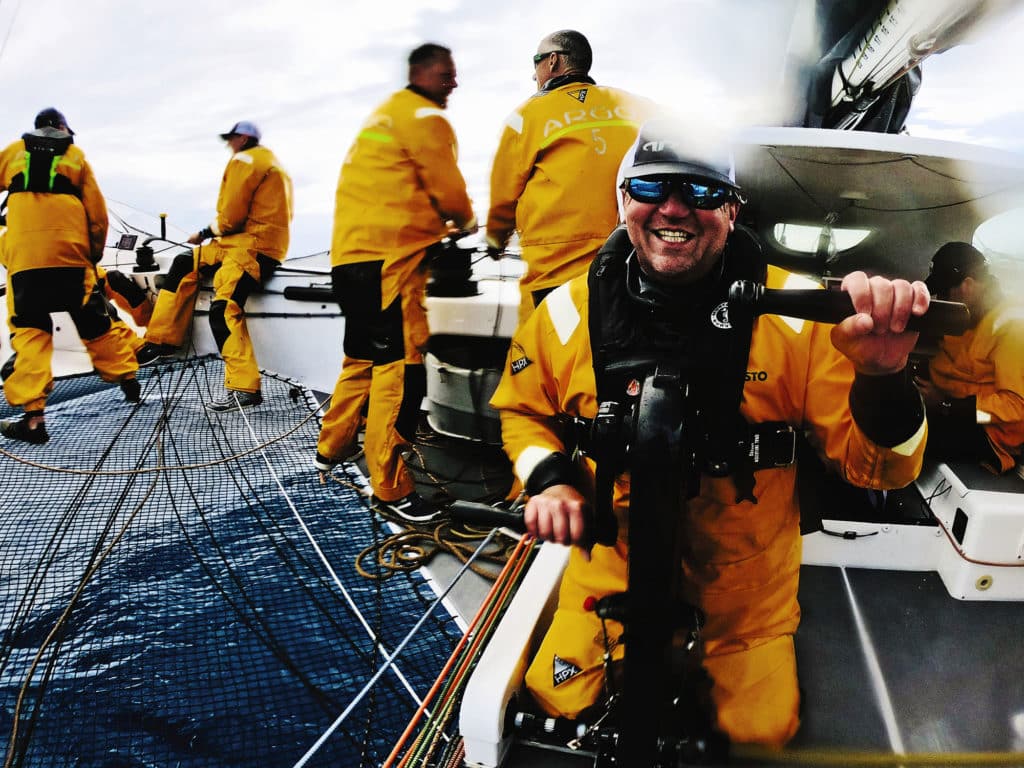
By the time the excitement wanes, Maserati has halved its deficit. Even though it was a blip on the radar mere minutes ago, in MOD70 racing, you can’t take your foot off the gas for a moment. Slow is slow. The crew shakes a reef, and after one final upwind leg, they cross the finish line first. There’s no time for handshakes or back slapping, though. The shoreline is fast approaching, so they tack and sail back out to sea. The race might be over, but the hard work is not.
“Hey, Helmet, hop on that pedestal and help me with the traveler,” Kotoun says.
Helmet is the nickname for English sailor Alister Richardson. A veteran of Carroll’s GC32 squad, Richardson is a former wing trimmer for America’s Cup challenger Luna Rossa, but he says he gets much more fulfillment from his Argo gig.
“I spent six years of my life doing the America’s Cup,” he tells me after racing. “Doing that is like joining the Army. It’s fine if you choose that lifestyle, but I enjoy sailing with Argo because I have good fun with these guys. We’re always pushing for performance, but at the end of the day, we’re having the time of our lives. Everyone can get a joke out of each other, which is important.”
That evening, the crew enjoys a private dinner at their rented condo in Port de Plaisance on the Dutch side of St. Martin. They debrief the day and pour a bit of rum, eventually gathering around a table for a late-night card game of President.
“We’re limited in what we can play because Jason will count the cards,” Corning says.
“Anything it takes to win,” Carroll replies mischievously.
Anything it takes—that’s the Argo way. Race hard, never give up, and have fun, no matter what.









